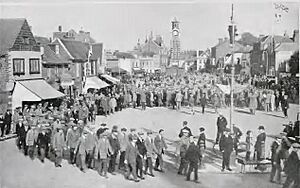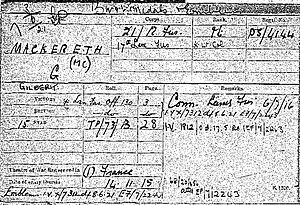Gilbert Mackereth facts for kids
Quick facts for kids
Sir Gilbert Mackereth
|
|
|---|---|
| Born | 19 October 1892 |
| Died | 11 January 1962 (aged 69) |
| Nationality | British |
| Occupation | British Consul, British Army officer |
Sir Gilbert Mackereth (born October 19, 1892 – died January 11, 1962) was a brave British Army officer during the First World War. After the war, he became a British diplomat, working for his country in different parts of the world. He was even the British Ambassador to Colombia from 1947 to 1953. Some people have called him 'the real James Bond' because of his exciting career!
Gilbert Mackereth started his army journey as a regular soldier in 1914. But he was very talented and quickly became an officer in 1916. He rose through the ranks to lead a whole battalion of soldiers. In 1917, he showed great courage by rescuing other soldiers while under heavy enemy fire. For this, he received a special award.
After the war, he left the army in 1919 and joined the diplomatic service. This meant he would represent Britain in other countries. He worked in several important roles in North Africa and the Middle East, even during the Second World War. After that, he went to the Dutch East Indies (now Indonesia) and then to Bogotá, Colombia, as an ambassador.
When he retired, he lived in Spain, where he passed away and was buried. Years later, his grave was almost moved because of unpaid taxes. But thanks to public support, his remains were brought back to England in 2011. He was reburied in a special garden in Bury, Greater Manchester. It is believed he was the first soldier from World War I to be brought back to England for burial since the famous Unknown Soldier in 1920.
Contents
Early Life and Family
Gilbert Mackereth was born in Salford, Lancashire, on October 19, 1892. He was an only child. His father, Thomas, worked as a bank manager. His mother, Annie, was from Bolton. Gilbert's grandfather, also named Thomas, was a minister at a church in Bolton.
Serving His Country in War
Joining the Royal Fusiliers
Gilbert Mackereth joined the army soon after World War I began. He signed up on November 19, 1914, as a private soldier with the Royal Fusiliers. He told them he worked as an "Insurance Surveyor." He joined the 21st Battalion, Royal Fusiliers, which was also known as the 4th Public Schools Battalion. This was a special unit made up of men from public schools and universities. It was formed in Epsom in 1914 as part of Kitchener's Army. This battalion fought in France. Many of its soldiers, like Mackereth, later became officers in other units.
Bravery with the Lancashire Fusiliers
On July 6, 1916, Mackereth became an officer, a second lieutenant, in the Lancashire Fusiliers. He was promoted to lieutenant on February 4, 1917. In April 1917, during a battle to capture Gricourt, he showed incredible bravery. He went 100 yards across open ground, under heavy enemy fire, to rescue a group of soldiers who were stuck in a dangerous area called "no man's land."
For his courage, he was given the Military Cross on June 18, 1917. The award said he showed "conspicuous gallantry and devotion to duty." It also mentioned that he made personal scouting trips and moved around without fear, even when shells were exploding nearby.
His military records show he first went to war on November 14, 1915. He received the Victory Medal, the British War Medal, and the 1914–15 Star. The Military Cross was also noted on his record. He was also "Mentioned in Despatches," which means his bravery was officially recognized in military reports.
Mackereth became an adjutant (an officer who helps the commander) on May 1, 1917. He then became an acting captain on August 3, 1917. On August 21, 1917, he was seriously wounded in the leg during a battle. He spent five months in the hospital. He returned to his battalion in France on June 15, 1918. He continued as adjutant for a short time. Then, he was promoted to acting major and became second-in-command of his battalion. Later, he became an acting lieutenant-colonel and led the 17th Battalion, Lancashire Fusiliers, for a period. He remained in command until April 24, 1919, when he left the army.
A Career in Diplomacy
After leaving the army, Mackereth joined the Diplomatic Service. This meant he would work for the British government in other countries. He married his wife, Muriel, in Jerusalem in 1921.
He worked as a vice-consul (a type of diplomat) in many places across North Africa and the Middle East. He was posted to Tangier in 1923, then to Fez, Morocco. His responsibilities grew, and he moved to Addis Ababa in 1930. In 1933, he returned to the Middle East, working as a consul in Damascus. He continued this role until 1939.
In 1937, he suggested increasing border patrols around Palestine. This was because many Jewish immigrants were fleeing Nazism in Hitler's Germany. At that time, France controlled Damascus.
Documents from 1938 show Mackereth's reports and letters about border control and security. These efforts were to stop arms smuggling and prevent people from crossing borders illegally.
During World War II, Mackereth continued his diplomatic work. On March 11, 1940, he returned to Addis Ababa as the Consul General. On April 30, 1941, he became Consul General in Ankara, Turkey. In 1945, he took the same role for French Morocco, living in Rabat.
After the Second World War, Mackereth was appointed Consul General in the Dutch East Indies (now Indonesia) in 1946. He helped bring order back to the region after the Japanese surrender. He ended his career as the British Ambassador to Colombia from 1947 to 1953.
Awards and Knighthood
Gilbert Mackereth received several important awards for his service. In 1939, he was made a Companion of the Order of St Michael and St George. This is a special honour given for service to the country.
In 1952, he was promoted to Knight Commander of the Order of St Michael and St George (KCMG). This meant he could use the title "Sir" before his name. He received this honour for his excellent work as the British Ambassador to Colombia.
Later Life and Reburial
Sir Gilbert Mackereth and his wife, Muriel, retired to San Sebastián in Northern Spain. He passed away on January 11, 1962, at the age of 69. He was buried in San Sebastián. His tombstone reads: "In Loving Memory of Sir Gilbert Mackereth KCMG MC." His wife returned to England and died in 1979. They did not have children, so after her death, his grave in Spain became neglected.
Saving His Grave
In May 2010, authorities in San Sebastián planned to move his body because of unpaid burial taxes. This caused a lot of concern in Britain. People started looking for his relatives in England, especially near Bolton.
News stories appeared on the BBC and in newspapers like The Daily Telegraph. Many people offered to pay the taxes to save his grave. A man named Terry Dean helped bring attention to the issue. He also found one of Mackereth's cousins, Mr. John Sloan. A newspaper called The Sun offered to pay the taxes, and the grave was saved from being moved.
Coming Home: Reburial in England
Later, it was decided with his family to bring his remains back to the UK. On November 11, 2011, Sir Gilbert Mackereth's cremated remains were buried in the Gallipoli Garden of Remembrance at the Fusilier Museum in Bury, Greater Manchester. It is believed that he was the first soldier from World War I to be brought back to England for burial since the Unknown Soldier was buried at Westminster Abbey in 1920.
|



